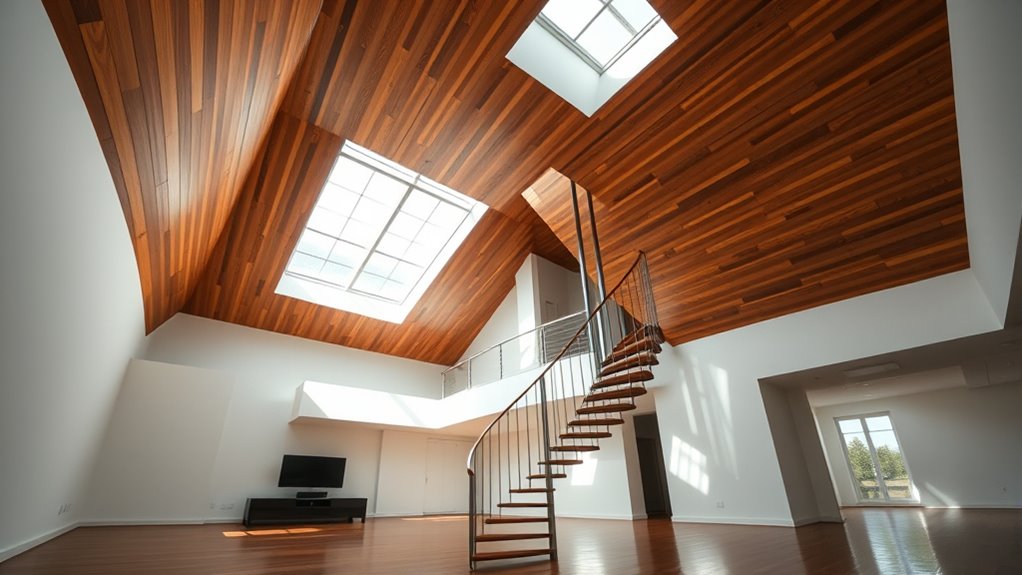The height of one floor varies depending on building type and design. In residential buildings, it’s typically 8 to 9 feet floor-to-ceiling, while commercial floors range from 12 to 18 feet to accommodate systems and functionality. Remember, floor-to-floor height includes structural elements and impacts overall building dimensions. Factors like local codes, mechanical system space, and architectural style also influence vloer height. Understanding these variables will clarify how floor height shapes building design and usability.
Standard Floor Heights in Residential Buildings

In most residential buildings, the standard floor height typically ranges between 8 to 9 feet, depending on local building codes and architectural design preferences. You’ll find that residential design balances spatial efficiency with comfort, often constrained by regulatory minimums for ceiling height to guarantee adequate ventilation and lighting. While 8 feet is the baseline in many jurisdictions, 9 feet or higher can create a more open ambiance, enhancing your living experience. Building codes dictate these parameters to maintain safety, energy efficiency, and accessibility standards, but they also allow flexibility for customization. Understanding these technical specifications lets you confidently navigate or influence residential design decisions, guaranteeing your space meets both regulatory requirements and personal freedom for spatial expression.
Commercial Building Floor Height Variations
Although commercial buildings serve varied purposes, their floor heights generally exceed those in residential structures to accommodate specialized systems and functional needs. When you analyze commercial building floor height variations, you’ll notice they’re influenced by height regulations, intended use, and infrastructure requirements. This table outlines typical floor heights by commercial type:
| Commercial Building Type | Typical Floor Height (ft) | Reason for Height Variation |
|---|---|---|
| Office Buildings | 12-14 | HVAC, lighting, wiring space |
| Retail Spaces | 14-18 | Display, signage, customer flow |
| Industrial Facilities | 16-20 | Machinery clearance, ventilation |
Understanding these variations helps you grasp how height regulations and functional demands shape commercial floor dimensions, giving you the freedom to plan or evaluate structures effectively.
Factors Affecting Floor-to-Floor Height

Variations in commercial floor heights stem from several underlying factors that directly impact floor-to-floor measurements. You’ll find that architectural styles play an essential role—modern designs often favor open, expansive spaces, requiring higher ceilings and therefore greater floor-to-floor heights. Conversely, traditional styles may adhere to more compact dimensions. Building codes also impose strict minimum requirements for ceiling height, structural elements, and mechanical systems, which you must incorporate into your planning. Additionally, the inclusion of HVAC systems, lighting, and fire suppression infrastructure necessitates additional clearance. When you’re designing or evaluating a building, understanding these influences helps you anticipate the spatial allowances needed between floors, ensuring compliance without compromising functional freedom or aesthetic intent. Balancing these technical demands lets you optimize floor-to-floor height effectively.
Measuring Floor Height: Floor-to-Ceiling vs. Floor-to-Floor
When measuring floor height, you need to distinguish between floor-to-ceiling and floor-to-floor dimensions. Floor-to-ceiling height refers to the clear vertical space within a room, while floor-to-floor height includes the thickness of structural elements between levels. Understanding these measurements and the factors influencing them is essential for accurate architectural planning and construction.
Defining Floor-to-Ceiling Height
Understanding floor-to-ceiling height is essential when measuring floor height, as it directly affects spatial perception and architectural design. This measurement defines the vertical distance from the finished floor surface to the ceiling below, influencing floor dimensions and ceiling styles you can implement. Unlike floor-to-floor height, it excludes structural components like floor slabs, giving you a clear sense of usable space. Here’s a concise comparison:
| Aspect | Definition/Impact |
|---|---|
| Measurement Point | Floor surface to ceiling |
| Affects | Interior volume, lighting, HVAC |
| Ceiling Styles | Flat, vaulted, coffered |
| Floor Dimensions | Usable height for design elements |
| Design Freedom | Greater control over interior spatial feel |
Knowing this helps you optimize both comfort and creativity in your spaces.
Understanding Floor-to-Floor Measurement
Although floor-to-ceiling height gives you the usable interior space, floor-to-floor measurement is essential for grasping the full vertical dimension of a building’s structure. This measurement captures the distance between the finished floor surfaces of two consecutive levels, reflecting not only room height but also slab thickness and structural components. Understanding this is vital when applying floor measurement techniques aligned with architectural standards. Key considerations include:
- Structural elements like beams and slabs that add to total floor height.
- Mechanical and electrical systems housed between floors influencing space allocation.
- Compliance with local codes that dictate minimum and maximum floor-to-floor dimensions.
Factors Affecting Floor Height
Because floor height impacts both structural integrity and occupant comfort, several factors must be considered when measuring it—particularly when distinguishing between floor-to-ceiling and floor-to-floor dimensions. You’ll need to account for design aesthetics, which influence ceiling height choices to create spaciousness or intimacy. Architectural regulations also play a critical role, imposing minimum standards for ceiling clearances and structural components. The floor-to-floor measurement includes slab thickness and any mechanical or electrical systems between levels, whereas floor-to-ceiling height focuses on usable vertical space within a room. Understanding these factors allows you to balance functional requirements with visual harmony, ensuring compliance without sacrificing freedom in spatial design. Precise measurement methods help optimize material use and occupant experience, essential in both residential and commercial projects.
Regional Differences in Floor Height Standards
When you compare buildings across different countries, you’ll notice that floor height standards vary considerably due to regional building codes, climate considerations, and cultural preferences. Understanding these differences requires analyzing how floor height regulations adapt to local needs and regional architectural styles.
- In colder climates, taller floors allow for better insulation layers and ventilation, influencing minimum floor-to-ceiling heights.
- Urban density impacts floor height regulations; densely populated cities often enforce lower floor heights to maximize usable space.
- Cultural preferences dictate aesthetic priorities, such as grandiose ceilings in traditional European architecture versus utilitarian heights in modern Asian designs.
Impact of Ceiling Design on Floor Height

You’ll find that standard ceiling heights typically range between 8 to 10 feet, directly influencing the overall floor-to-floor measurement. A taller ceiling can make a room feel more spacious, altering your perception of the floor height. Understanding this relationship is key when evaluating or designing interior spaces.
Standard Ceiling Height
Ceiling height plays an essential role in determining the overall floor-to-floor measurement in a building. When considering standard ceiling height, you’ll find it typically ranges between 8 to 9 feet, balancing functional space with construction efficiency. This height accommodates standard ceiling materials without compromising structural integrity or ideal ceiling aesthetics. You should consider these factors:
- Material thickness: Standard ceiling materials like gypsum board or plaster influence the ceiling’s finished height and must be accounted for in design.
- Mechanical systems: HVAC ducts and lighting fixtures require sufficient clearance, potentially increasing ceiling height.
- Building codes: Local regulations often dictate minimum ceiling heights for habitability and safety.
Effects on Room Perception
Although floor-to-floor height sets the physical limits of a room, the ceiling design greatly influences how spacious or confined the area feels. When you optimize ceiling elements—like height variations, textures, and lighting—you directly impact the room ambiance and spatial perception. For instance, a vaulted or coffered ceiling can create an illusion of expansiveness, making the floor height feel more generous without altering structural dimensions. Conversely, low, flat ceilings may compress the space, restricting psychological freedom despite adequate floor-to-floor height. Strategic use of reflective surfaces and indirect lighting further enhances vertical perception, promoting openness. By understanding these design interactions, you can manipulate perceived volume to achieve a desired sense of freedom within any space, ultimately transforming how you experience the vertical boundaries set by floor-to-floor measurements.
Floor Height Considerations in Multi-Story Buildings
When designing multi-story buildings, understanding floor height considerations is vital for optimizing structural integrity, occupant comfort, and mechanical system integration. You must navigate floor height regulations and architectural considerations to guarantee compliance and functionality. Key factors include:
- Structural Load and Material Limits: Higher floors require stronger supports; balancing floor-to-floor height with material capabilities is critical.
- Mechanical and Electrical Systems: You need adequate space for HVAC, plumbing, and wiring between floors without compromising ceiling height.
- Occupant Comfort and Accessibility: Floor heights impact natural light penetration, ventilation, and emergency egress routes.
How Floor Height Influences Building Design and Functionality
Understanding how floor height affects a building’s design and functionality helps you make informed decisions about spatial planning and system integration. Floor height directly impacts structural requirements, HVAC system efficiency, and natural light penetration. When you optimize floor design, you achieve a functionality balance that enhances occupant comfort and operational efficiency. Too low a floor height restricts mechanical system placement and reduces flexibility, while excessive height increases construction costs and energy consumption. By precisely calibrating floor height, you enable efficient routing of ducts, wiring, and plumbing without compromising usable space. This balance also influences aesthetic proportions and potential adaptability for future use. Ultimately, mindful floor height selection aligns architectural intent with practical needs, granting you freedom to create spaces that perform well while accommodating evolving functional demands.




